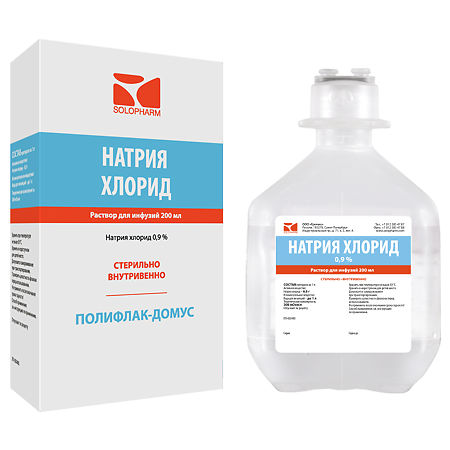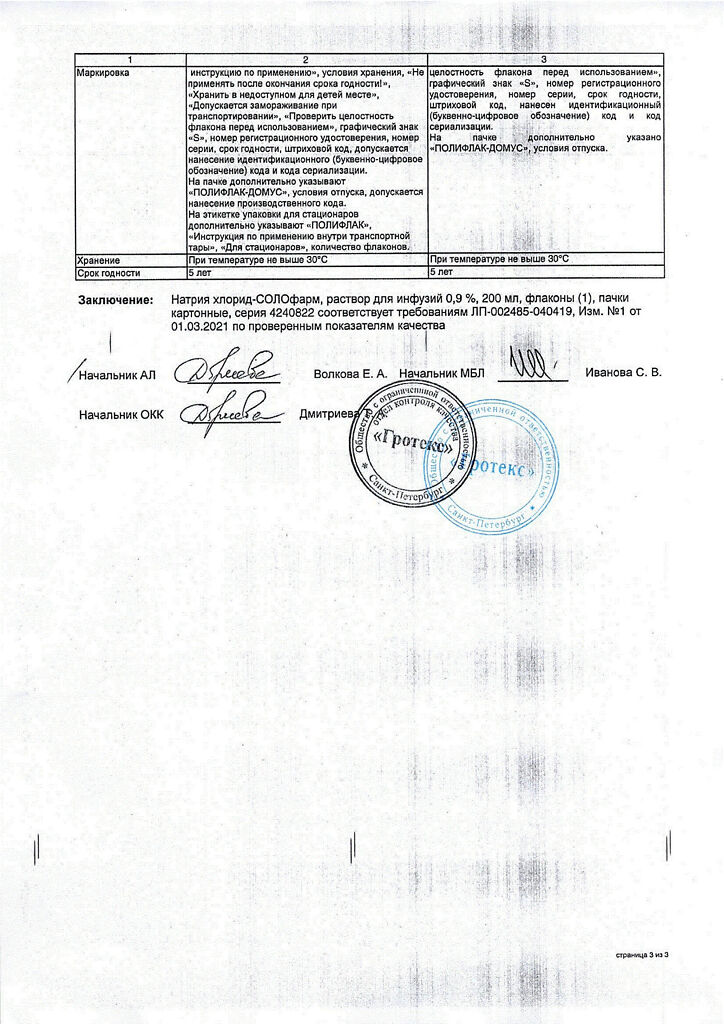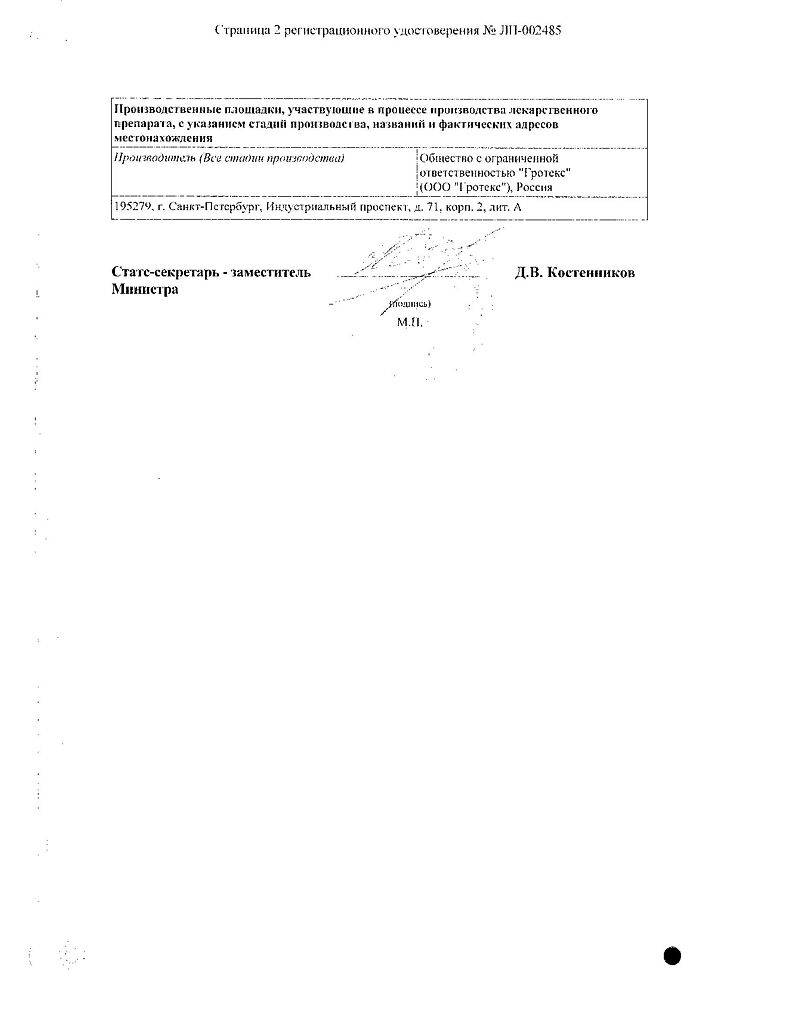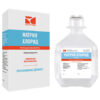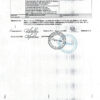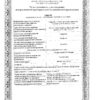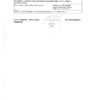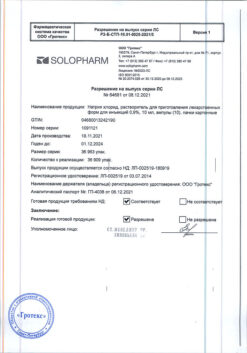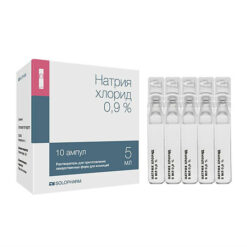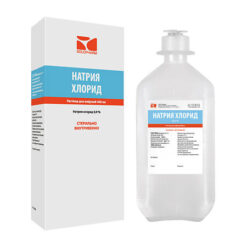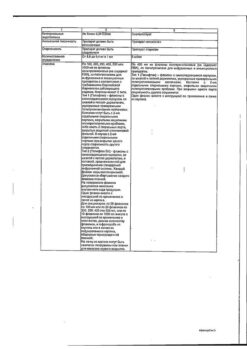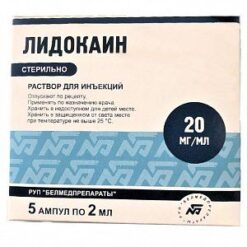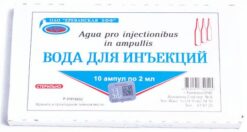No products in the cart.
Sodium chloride-SOLOPHarm Domus, 0.9% 200 ml
€2.00
EAN: 4680013240110
SKU: 280042
Categories: Anesthesia and resuscitation, Anesthesia solutions, Medicine
Description
It has a detoxifying and rehydrating effect. It replenishes sodium deficiency in various pathological states of the body and temporarily increases the volume of fluid circulating in blood vessels.
The pharmacodynamic properties of the solution are due to the presence of sodium ions and chloride ions. A number of ions, including sodium ions, pass through the cell membrane by various transport mechanisms, among which the sodium-potassium pump (Na-K-ATPase) is important.
Sodium plays an important role in signal transduction in neurons, the electrophysiological processes of the heart, and in metabolic processes in the kidneys.
Sodium is excreted primarily by the kidneys, however, a large amount of sodium is reabsorbed (renal reabsorption). A small amount of sodium is excreted in the feces and by perspiration.
Indications
Indications
– isotonic extracellular dehydration;
– hyponatremia;
— dilution and dissolution of parenterally administered medicinal substances (as a base solution).
Pharmacological effect
Pharmacological effect
Has a detoxifying and rehydrating effect. Replenishes sodium deficiency in various pathological conditions of the body and temporarily increases the volume of fluid circulating in the vessels.
The pharmacodynamic properties of the solution are due to the presence of sodium and chloride ions. A number of ions, including sodium ions, penetrate the cell membrane using various transport mechanisms, among which the sodium-potassium pump (Na-K-ATPase) is of great importance.
Sodium plays an important role in neuronal signal transmission, electrophysiological processes in the heart, and metabolic processes in the kidneys.
Sodium is excreted primarily by the kidneys, however, large amounts of sodium are reabsorbed (renal reabsorption). A small amount of sodium is excreted in feces and through sweating.
Special instructions
Special instructions
When carrying out any infusion, it is necessary to monitor the patient’s condition, clinical biological indicators, it is especially important to evaluate blood plasma electrolytes.
In children, sodium excretion may slow down due to immature kidney function. Therefore, in such patients, repeated infusions should be carried out only after determining the concentration of sodium in the blood plasma.
If hypersensitivity reactions or infusion reactions occur, the infusion should be stopped immediately and the necessary therapeutic measures taken as indicated.
Depending on the volume and rate of infusion, intravenous administration of the drug may pose a risk of hypervolemia and/or solute overload and electrolyte imbalance.
In patients with renal failure, the drug should be used with extreme caution or not used at all. Use of the drug in such patients may lead to sodium retention.
Use only a clear solution, without visible inclusions and if the packaging is not damaged. Administer immediately after connecting to the infusion system. The solution should be administered using sterile equipment in compliance with the rules of asepsis and antisepsis. To prevent air from entering the infusion system, fill it with solution, releasing any remaining air from the container completely.
As with all parenteral solutions, the compatibility of added substances with the solution must be determined before reconstitution. Drugs known to be incompatible with it should not be used with 0.9% sodium chloride solution.
A doctor should determine the compatibility of added medicinal substances with a 0.9% sodium chloride solution by checking for possible changes in color and/or the appearance of sediment, insoluble complexes or crystals. Before addition, it is necessary to determine whether the substance being added is soluble and stable in water at the pH level of a 0.9% sodium chloride solution. When adding a drug, it is necessary to determine the isotonicity of the resulting solution before administration.
Before adding drugs to the solution, they must be thoroughly mixed in compliance with aseptic rules. The prepared solution should be administered immediately after preparation, do not store! Any unused dose should be discarded.
Active ingredient
Active ingredient
Sodium chloride
Composition
Composition
Sodium chloride 9 g,
Contraindications
Contraindications
– hypernatremia, acidosis, hyperchloremia, hypokalemia, extracellular hyperhydration;
– circulatory disorders that threaten cerebral and pulmonary edema;
– cerebral edema, pulmonary edema, acute left ventricular failure, concomitant administration of corticosteroids in large doses.
When adding other drugs to the solution, it is necessary to take into account contraindications to these drugs.
With caution: decompensated chronic heart failure, arterial hypertension, peripheral edema, preeclampsia, chronic renal failure (oligo-, anuria), aldosteronism and other conditions associated with sodium retention in the body.
Side Effects
Side Effects
Acidosis, overhydration, hypokalemia.
When used correctly, unwanted effects are unlikely.
When using sodium chloride solution 0.9% as a base solution (solvent) for other drugs, the likelihood of side effects is determined by the properties of these drugs. In this case, if adverse reactions occur, the administration of the solution should be suspended, the patient’s condition assessed, adequate measures taken, and the remaining solution retained for analysis, if necessary.
If any of the side effects indicated in the instructions get worse, or you notice any other side effects not listed in the instructions, tell your doctor.
Interaction
Interaction
Compatible with colloid hemodynamic blood substitutes (mutually enhancing effect).
When mixing with other drugs, it is necessary to visually monitor compatibility.
Overdose
Overdose
Symptoms: nausea, vomiting, diarrhea, cramping abdominal pain, thirst, decreased salivation and lacrimation, increased sweating, fever, tachycardia, increased blood pressure, renal failure, peripheral edema, pulmonary edema, respiratory arrest, headache, dizziness, anxiety, irritability, weakness, muscle cramps and rigidity, generalized convulsions, coma and death.
Excessive administration of sodium chloride solution 0.9% can cause hypernatremia.
Excessive intake of chloride into the body can lead to hyperchloremic acidosis. If a solution of sodium chloride 0.9% is used as a base solution for the dilution and transport of other drugs, symptoms and complaints with excessive administration are most often associated with the properties of the drugs added to the solution.
In case of unintentional over-administration of the solution, treatment should be stopped and the patient’s condition assessed.
Treatment: symptomatic.
Manufacturer
Manufacturer
Grotex LLC, Russia
Additional information
| Manufacturer | Grotex Ltd, Russia |
|---|---|
| Medication form | solution for infusion |
| Brand | Grotex Ltd |
Other forms…
Related products
Buy Sodium chloride-SOLOPHarm Domus, 0.9% 200 ml with delivery to USA, UK, Europe and over 120 other countries.

